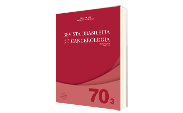Dry Needling in Postoperative Breast Cancer: Influence on Pain and Shoulder Range of Motion – Pilot Study
DOI:
https://doi.org/10.32635/2176-9745.RBC.2024v70n3.4748Keywords:
Dry Needling/methods, Breast Neoplasms/surgery, Range of Motion, Articular, Musculoskeletal PainAbstract
Introduction: The estimated number of new cases of breast cancer in Brazil is 73,610 annually in 2023, according to the National Cancer Institute. Treatments for breast cancer can lead to adverse events such as muscle pain and limitation of shoulder range of motion. Myofascial pain is reported in 38% to 85% of patients. Among the treatments, the technique of dry needling is minimally invasive and consists of inserting a thin needle into the muscle fascia directly at the myofascial point. Objective: To evaluate whether dry needling influences musculoskeletal pain and shoulder range of motion in postoperative breast cancer patients. Method: The study included ten women with limited lange of motion in flexion and abduction of the limp ipsilateral to surgery, whether presenting pain or not when in movement. Range of motion of flexion and abduction was assessed using a goniometer and pain using the visual analog scale. Two weekly sessions of dry needling were performed for three weeks. The needle used was an acupuncture needle, characterized as solid filament without medication. Results: There was a significant reduction in pain scores (p = 0.0006) and a significant improvement in range of motion, with an increase of approximately 50 degrees of flexion and abduction (p = 0.0002). Conclusion: Dry needling appears to be a promising technique in reducing pain and improving shoulder range of motion in the postoperative period of breast cancer.
Downloads
References
Instituto Nacional de Câncer. Estimativa 2023: incidência do câncer no Brasil [Internet]. Rio de Janeiro: INCA; 2022. [acesso 2024 abr 25]. Disponível em: https://www.inca.gov.br/sites/ufu.sti.inca.local/files//media/document//estimativa-2023.pdf
Gradishar WJ, Moran MS, Abraham J, et al. NCCN Guidelines® Insights: Breast Cancer, Version 4.2023. J Natl Compr Canc Netw. 2023;21(6):594-608. doi: https://doi.org/10.6004/jnccn.2023.0031 DOI: https://doi.org/10.6004/jnccn.2023.0031
Kalichman L, Menahem I, Treger I. Myofascial component of cancer pain review. J Bodyw Mov Ther. 2019;23(2):311-5. doi: https://doi.org/10.1016/j. jbmt.2019.02.011 DOI: https://doi.org/10.1016/j.jbmt.2019.02.011
Macedo CF, Sonza A, Puel AN, et al. Trigger point dry needling increases masseter muscle oxygenation in patients with temporomandibular disorder. J Appl Oral Sci. 2023;31:e20230099. doi: https://doi.org/10.1590/1678-7757-2023-0099 DOI: https://doi.org/10.1590/1678-7757-2023-0099
Dommerholt J. Dry needling - peripheral and central considerations. J Man Manip Ther. 2011;19(4):223-7. doi: https://doi.org/10.1179/106698111x13129729552065 DOI: https://doi.org/10.1179/106698111X13129729552065
Navarro-Santana MJ, Sanchez-Infante J, Fernández-de-Las-Peñas C, et al. Eficácia do agulhamento seco para pontos-gatilho miofasciais associados a sintomas de dor no pescoço: uma revisão sistemática atualizada e metanálise. J Clin Med. 2020;9(10):3300. doi: https://doi.org/10.3390/jcm9103300 DOI: https://doi.org/10.3390/jcm9103300
García-de la-Banda-García R, Cortés-Pérez I, Ibancos-Losada MDR, et al. Effectiveness of dry needling versus manual therapy in myofascial temporomandibular disorders: a single-blind randomized controlled trial. J Pers Med. 2023;13(9):1415. doi: https://doi.org/10.3390/jpm13091415 DOI: https://doi.org/10.3390/jpm13091415
Conselho Nacional de Saúde (BR). Resolução nº 466, de 12 de dezembro de 2012. Aprova as diretrizes e normas regulamentadoras de pesquisas envolvendo seres humanos. Diário Oficial da União, Brasília, DF. 2013 jun 13; Seção I:59.
Torres Lacomba M, Mayoral del Moral O, Coperias Zazo JL, et al. Incidence of myofascial pain syndrome in breast cancer surgery: a prospective study. Clin J Pain. 2010;26(4):320-5. doi: https://doi.org/10.1097/ajp.0b013e3181c4904a DOI: https://doi.org/10.1097/AJP.0b013e3181c4904a
Ziaeifar M, Arab AM, Mosallanezhad Z, et al. Dry needling versus trigger point compression of the upper trapezius: a randomized clinical trial with two-week and three-month follow-up. J Man Manip Ther. 2019;27(3):152-61. doi: https://doi.org/10.1080/1066 9817.2018.1530421 DOI: https://doi.org/10.1080/10669817.2018.1530421
Shah JP. Integrating dry needling with new concepts of myofascial pain, muscle physiology, and sensitization. In: Audete JF, Bailey A, editores. Integrative Pain Medicine. Los Angeles: Springer; 2008. p. 107-21. doi: http://dx.doi.org/10.1007/978-1-59745-344-8_5 DOI: https://doi.org/10.1007/978-1-59745-344-8_5
Dommerholt J, Bron C, Franssen J. Pontos-gatilho miofasciais: uma revisão baseada em evidências. J Man Manip Ther. 2006;14(4):203-21. doi: https://doi.org/10.1179/106698106790819991 DOI: https://doi.org/10.1179/106698106790819991
Shah JP, Gilliams EA. Uncovering the biochemical milieu of myofascial trigger points using in vivo microdialysis: an application of muscle pain concepts to myofascial pain syndrome. J Bodyw Mov Ther. 2008;12(4):371-84. doi: https://doi.org/10.1016/j.jbmt.2008.06.006 DOI: https://doi.org/10.1016/j.jbmt.2008.06.006
Published
How to Cite
Issue
Section
License
Os direitos morais e intelectuais dos artigos pertencem aos respectivos autores, que concedem à RBC o direito de publicação.

This work is licensed under a Creative Commons Attribution 4.0 International License.









